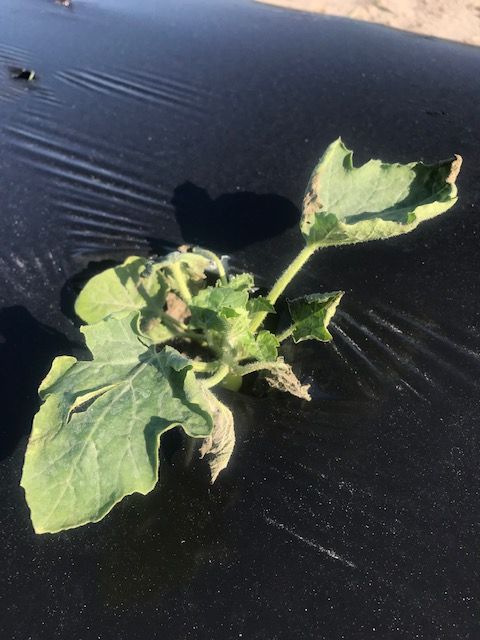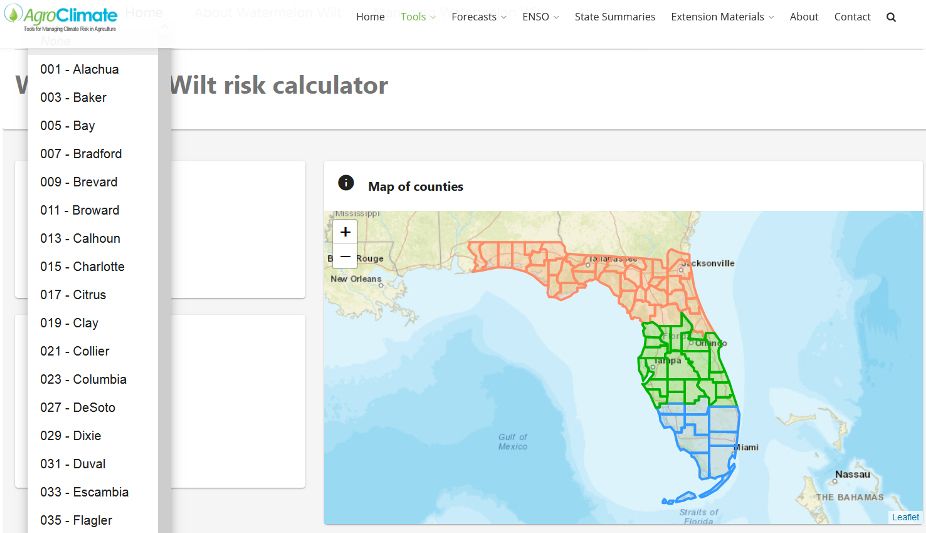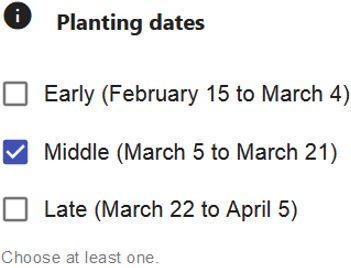Abstract
Fusarium wilt of watermelon, caused by the fungus Fusarium oxysporum f. sp. niveum, is a threat to watermelon production in Florida. While a number of management options are available, numerous factors influence which management strategies are feasible for growers. In this paper, we introduce a tool that calculates the estimated risk of Fusarium wilt based on potential management strategies and environmental factors. This tool is intended for use by watermelon growers in Florida and should be helpful in advising them on management decisions.
Introduction
Watermelon is an important, high-value crop in Florida. In 2021, Florida was the leading producer of watermelons in the United States, accounting for nearly 30%, or about 1.02 billion pounds, of the nation’s production.1 Fusarium wilt (FW) of watermelon is a disease caused by the soilborne fungus Fusarium oxysporum f. sp. niveum. The fungus resides in the soil, sometimes for years, enters hosts through the roots, and then advances into the vascular tissue. The primary symptoms are gradual wilt of the plant foliage, followed by full plant collapse2 (Figure 1). Additionally, the vascular tissue inside the stem will be discolored to red or brown.2 There is no recent data on Fusarium wilt losses for watermelon nationwide or worldwide; however, field trials have shown that the disease has the potential to eliminate all marketable yield in a given area.3 Currently, the primary methods for managing Fusarium wilt on watermelon in Florida include rotating the fields the watermelons are grown in, growing FW-resistant watermelon varieties, planting seedlings that have been grafted with FW-resistant rootstocks, fumigating soil prior to planting, and planting late to take advantage of temperatures less favorable to the pathogen (Table 1).

Credit: Dufault Lab, 2021
Table 1. Current management options for Fusarium wilt in Florida.
Here, a new risk assessment tool for Fusarium wilt of watermelon in Florida is described. It is intended for use by growers but is useful for Extension agents and researchers as well. The tool uses data on the history of climate and disease in a given location, coupled with specific management decisions, to calculate the estimated disease risk (Figure 2). The goal is to provide support information related to Fusarium wilt management. It is not intended to make direct recommendations, but rather to show growers how certain actions in a given setting affect the likelihood of Fusarium wilt occurring in their field, so that they can then make the best decision in their situation.

Credit: UF/IFAS
Description of the Risk Calculator Features
The Choose a county feature is used to specify the county in which the field is located. This is needed to determine the planting dates that are considered “early,” “middle,” or “late” and to account for climate trends that may favor or inhibit the pathogen. Users can either select their county from the drop-down menu or from the interactive Map of counties in Florida (Figure 3).

Credit: UF/IFAS
Risk level estimations are, in part, based on observation of the pathogen. In the Detected by Bioassay feature, users select whether or not a soil bioassay has led to the detection of the Fusarium wilt pathogen in their field. “Yes,” meaning a positive result, confirms the presence of the pathogen, whereas “No,” meaning a negative result, indicates that the pathogen was not found in the sample, but not that the field is disease-free (Figure 4).

Credit: UF/IFAS
In the Fusarium wilt history feature, the user simply confirms whether the disease has occurred in the field at a macroscopic level in the past. If the user answers “Yes,” then a second question appears to determine the most recent outbreak or planting in this field. A more recent outbreak presents a higher risk in the current season. Additionally, a more recent planting of watermelon in a field that has had Fusarium wilt in the past suggests that more of the pathogen might still be present in the field. The second question on the Fusarium wilt history feature is also relevant to management, because it takes the benefits from using a crop rotation system into account (Figure 5).

Credit: UF/IFAS
The other features calculate risk based on additional management decisions. The Grafted roots feature instructs users to select whether they plan to use plants grafted with resistant rootstocks. Selecting “Yes” on this feature reduces the risk of disease to almost zero. The Fumigation feature lets users select whether they have fumigated their field. Selecting “Yes” leads to a second question to choose between the fumigants chloropicrin, which has some efficacy against Fusarium wilt, and Telone®, which has no observed efficacy against Fusarium wilt but is sometimes used against nematodes and other watermelon pests (Figure 6).

Credit: UF/IFAS
Finally, the Planting dates feature provides a series of “early,” “middle,” or “late” ranges of planting dates based on the region/county selected. The user can select one or more of these ranges during which they plan to plant. “Middle” or “late” planting may reduce the risk of disease depending on other factors (Figure 7).

Credit: UF/IFAS
A summary of the most common effects of each feature on disease risk is shown in Table 2. Users can access this tool through the website and gain access to Extension material about the disease, other major watermelon pathogens and pests, management techniques, and Fusarium wilt information relevant to other states. No subscription is required.
Table 2. Most common effects of tool features on Fusarium Wilt (FW) risk on watermelons in Florida. Some factors have a greater impact on risk than others. Certain factors can negate the effects of others.
Demonstration of Efficacy
As this tool is released, the number of users and how frequently they access it will be analyzed, and how commonly watermelon growers in each region of Florida use it will be estimated. It is planned to include this as a part of the annual watermelon survey to analyze how growers who have used it have fared in yield and profit compared to those who have not. Use of the tool will hopefully generate critical user feedback as well as data sharing from users to identify knowledge gaps related to disease management and other impacts on Fusarium wilt of watermelon in Florida.
Conclusions
The Fusarium wilt risk calculator presents a new opportunity for growers to recognize and quantify the benefits of integrated Fusarium wilt management. It helps growers to be informed about disease risk while deciding the best actions for their field. Importantly, the information in this tool is specific to Fusarium wilt of watermelon in Florida. Knowledge gaps still exist for this tool in relation to common management practices such as host resistance, fungicide usage and cover crops for disease suppression as well as weather influences on disease in season and the economic impacts of various integrated management tool selection. However, we are optimistic about the positive impact this tool will have on Fusarium wilt of watermelon management in Florida. We also anticipate to add new and/or enhanced features to this online tool for improving its functionality and adaptability based on user feedback.
References
United States Department of Agriculture National Agriculture Statistics Service. 2022. “Vegetables 2021 Summary.” https://downloads.usda.library.cornell.edu/usda-esmis/files/02870v86p/zs25zc490/9593vz15q/vegean22.pdf
Roberts, P., N. Dufault, R. Hochmuth, G. Vallad, and M. Paret. 2019. “Fusarium Wilt (Fusarium oxysporum f. sp. niveum) of Watermelon.” EDIS 2019 (5): 4. https://doi.org/10.32473/edis-pp352-2019
Ioannou, N., C. A. Poullis, and J. B. Heale. 2000. “Fusarium Wilt of Watermelon in Cyprus and Its Management with Soil Solarization Combined with Fumigation or Ammonium Fertilizers.” EPPO Bulletin 30 (2): 223–230. https://doi.org/10.1111/j.1365-2338.2000.tb00884.x